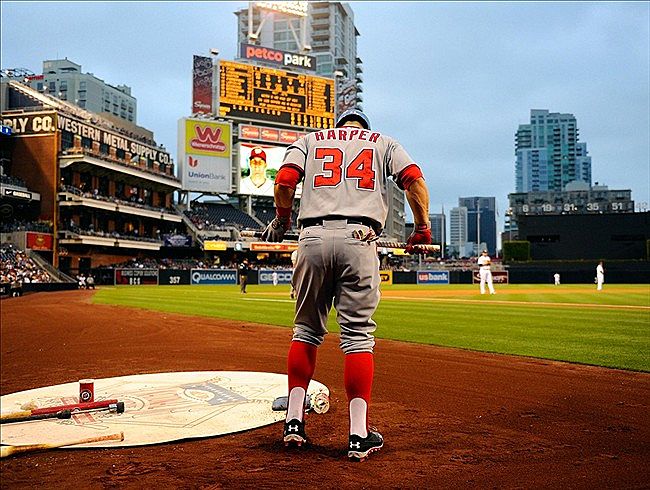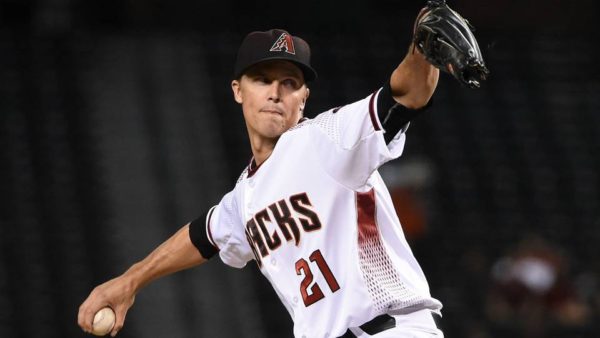Bryce Harper, and the History of Committing Significant Payroll to One Player


With the San Diego Padres rumored to be involved with multiple high-profile free-agents and trade targets, it is reasonable to consider whether they really have reason to pursue Bryce Harper. While the discussions surrounding a potential signing of the superstar have been popular, it remains imperative that we first delve into the financial ramifications of Harper agreeing to a deal with San Diego.
It has been a very quiet offseason for a typically busy Padres front office, who just left the winter meetings without engaging in any significant transactions.
Padres fans are bored, largely because A.J. Preller is usually busy with a trade, or drafting intriguing young players in the Rule 5 draft. The team is frequently mentioned in trade and free agent rumors, yet their willingness to actually carry out potential moves has been noticeably less this winter. This lack of action has caused many in the Padres’ fanbase to feel uneasy, and anxious about the team.
These sentiments have led many to believe that the Padres should make a run at a potential Bryce Harper signing. Considering that multiple big-market clubs have not been rumored to be interested in signing the 26-year-old outfielder, it’s actually worth considering whether San Diego has reason to add him to their roster on a hefty contract.
To fully understand the realities of a Harper signing, we should look at previous examples of teams that have committed a significant portion of their payroll to one player.
It’s clear the Padres have the payroll space to afford Harper, so the question then becomes: Have teams been successful when paying a singular superstar a heap of money more than the rest of their players? To start, we need to find examples of teams that have already engaged in this ambitious endeavor. For example, the Diamondbacks signing of Zack Greinke in 2015, a contract which left the team spending 34.7% of their payroll on him (Courtesy of Spotrac).
Here are the free-agent signees from the last five years, whose salaries in their first season took up at least 20% of their team’s payroll:
Free Agents Signed From Winter 2013 – Present (Minimum Five-Year Contract)
| Player | Age When Signed | Signed | Contract Years / $ Value | Year 1 Salary |
Year 1 Salary % of Team Payroll
|
| Robinson Cano | 31 | December 2013 | 10/240M | 24.05M | 22.5% |
| Zack Greinke | 32 | December 2015 | 6/206.5M | 34M | 34.7% |
| Eric Hosmer | 28 | February 2018 | 8/144M | 21M | 20.2% |
These are the lone three players who fit the description above, which speaks to how bold a move it really is for a team to commit so much money to one player.
Rarely do we see high-profile signees agree to terms with teams that are not considered to be big-market clubs, such as the Mariners, Diamondbacks, and Padres. While it’s too early to judge the Padres for the Hosmer contract, we can definitely see the consequences that Arizona and Seattle are facing, following their signings of Canó and Greinke.

The Mariners have come close to clinching a wildcard berth in the years after bringing in Canó, yet this offseason, have begun to rebuild. In trading Canó to the Mets this winter, it became clear that the team wanted to be rid of his hefty salary. So much for being able to afford to pay one player so much money, huh?
Arizona found a little more success by making it to the Divisional Round of the playoffs during the 2017 season, yet otherwise have been mediocre with Greinke during the 2016 and 2018 seasons. The trade of Paul Goldschmidt to the Cardinals, and rumors of the Diamondbacks interest in trading Greinke, indicate that they are contemplating a rebuild. Both signings crippled the organizations that were responsible for them, making it much more difficult for the teams to bring in other talented players while they were in win-now mode.
Considering what we have heard surrounding Bryce Harper’s contract demands, it would take a payroll commitment similar to the ones discussed above regarding Canó and Greinke. Let’s explore the specific financial realities the Padres would face if signing Harper this offseason. Barring unforeseen circumstances, Harper will very likely sign a contract worth at least $300 million. Anywhere from $300 to $350 million in total contract value is what we can assume at this point in time. We need to figure out how Harper’s yearly salary would be weighted in the Padres’ payroll during the 2019 season, given the assumptions above. Here are the results:
*The Padres’ 2019 payroll is currently projected to be $64,220,000 according to Spotrac*
| Salary ($) | Percentage of Padres’ Current 2019 Payroll |
| 30,000,000 | 46.7% |
| 31,000,000 | 48.3% |
| 32,000,000 | 49.8% |
| 33,000,000 | 51.4% |
| 34,000,000 | 52.9% |
| 35,000,000 | 54.5% |
Furthermore, here are the equivalent percentages of the Padres’ 2019 payroll Harper would be taking up, once signed. These values tell us the same percentage he would be taking up in the team payroll as listed for Canó and Greinke earlier:
| Salary ($) | Percentage of Padres’ 2019 Payroll |
| 30,000,000 | 31.8% |
| 31,000,000 | 32.5% |
| 32,000,000 | 33.2% |
| 33,000,000 | 33.9% |
| 34,000,000 | 34.6% |
| 35,000,000 | 35.3% |
These percentages put the Harper situation in perspective, and make it clear that signing him would be extremely ambitious for the Padres’ organization. To be clear, the team is coming off a rebuilding season, and will obviously have a larger payroll in more competitive future seasons. Nonetheless, the amount of money owed to Harper in a potential signing is simply too much for the Padres to risk taking on. Having Bryce Harper would be great for the team’s performance, but it would leave very little room for error in the decision making process of GM A.J. Preller and Co.
The fact of the matter is that teams with significant financial commitments to one player are limited in their ability to sign and trade for additional players. If the Padres signed Harper today, would they be able to re-sign Fernando Tatis Jr. in 6-7 years? Assuming Harper gets a ten-year deal, it certainly would be more difficult to hold onto the highly-touted shortstop prospect. Considering how difficult it became for the Diamondbacks and Mariners following their free-agent signings of Canó and Greinke, the Padres would be wise to save their money for multiple players. Signing Harper would be exciting and fun, but it would put the team under immense pressure to carefully handle the little money left after making such a move.
*All salary data in this article was taken from Spotrac*
A sophomore at Willamette University in Oregon, Conrad is majoring in Spanish but is also a writing center assistant for other students at Willamette. He has been a Padres die-hard his whole life and hopes to bring comprehensible statistical analysis to the site.
I really can’t believe anyone would argue against adding Harper.
Your argument is flawed when considering the Padres because although their payroll is low, it’s not staying at $64 mm. For the club to compete in the future a payroll in the $150-160 million range will be required. Paying Harper $35 mm looks much less lopsided when seen that way. Especially if Myers is traded, and even a small portion of his salary saved.
You gloss over Harper being a very good player in his prime. The emphasis should be on adding just such talent, and not on worrying about Ron Fowler’s bank account. Since we don’t have a single good player in his prime, this is a crucial step forward.
And if one is really concerned about people who own a billion dollar asset, remember that it is possible that a Harper signing would generate enthusiasm that would drive ticket sales, thereby recouping some of the money laid out. If the same 10% bump in ticket sales that happened in 2015 occurs here, that would more than pay for Harper’s salary.
This is a fine article, but I’d like to see an addendum however: the percentage of payroll that goes to one position. Myers (who WAS the first baseman of the future) + Hosmer = _____% of the Padres payroll (at least next year) It could be upwards of 40 to 50 percent.
Too early to judge the Hosmer contract??? It was horrific and crippling the moment it was signed. There was no need for a first baseman. There was no one else competing for Hosmer. He is not that good. He plays a position of low importance. They massively overpaid him. It should a three year contract, at most. He will decline more and more. All those things we can judge right now (we could add other problems as well).
The Mariners traded Cano and the Diamondbacks would like to dump Greinke. Any takers for Hosmer?
One of the first articles on EVT that I’ve read that was actually well written and factual. Bravo.
Thank you! I am glad you liked my article.